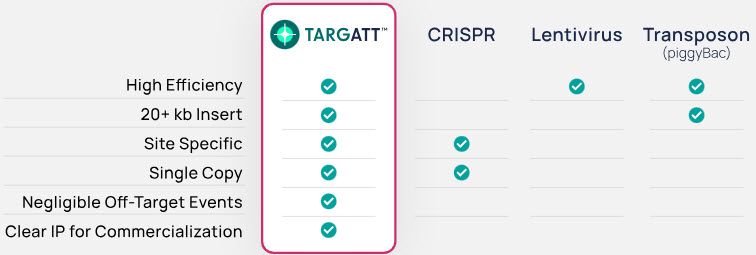TARGATT™ iPSC Kits

Build cell-based models of disease and accelerate therapeutic development with TARGATT™ large knock-in technology in iPSCs.
Large DNA knock-ins—virtually any human cell type
Whether you are creating tomorrow’s iPSC-based treatments or building a cellular model of disease, TARGATT™ iPSC kits will simplify and accelerate cell line development when you need to knock-in and express one or more genes.
Combining the power and safety of our TARGATT™ large knock-in technology with the scalability and isogenic consistency of iPSCs, TARGATT™ iPSC Kits enable genome engineering that CRISPR, transposons, and lentivirus can’t handle.
Expand what you can accomplish in iPSCs with TARGATT™ technology

Available TARGATT™ iPSC Kits
TARGATT™ Kits are designed to enable easy evaluation of the technology before purchasing a license.* Each TARGATT™ iPSC kit includes a human iPS cell line with the TARGATT™ landing pad already inserted into the H11 safe harbor site, a donor plasmid for the DNA you are knocking in, and a TARGATT™ Integrase expression plasmid.
TARGATT™ kits are available with iPSCs derived from male CD34+ umbilical cord blood cells (AST-9450, AST-9480, AST-9650) as well as iPSCs derived from fibroblasts from an adult female donor (AST-1602).
Contact us if you wish to purchase additional kit components.
*Academic researchers may purchase TARGATT™ technology without licensing. Request more information.
Why you should choose TARGATT™ iPSC Kits
- Efficient integration—over 90% after selection
- Consistent expression from clone to clone
- Large cargo knock-in—up to 20 kb in a single reaction, more with nested reactions
- Site-specific integration into the H11 safe harbor site
- Single-copy insertion
Learn how TARGATT™ technology works and see the data—visit the technology page.
Publications about TARGATT™ technology
- Chi, X., Zheng, Q., Jiang, R., Chen-Tsai, R. Y., & Kong, L. J. (2019). A system for site-specific integration of transgenes in mammalian cells. PLOS ONE, 14(7), e0219842.
- Zhu, F., Gamboa, M., Farruggio, A. P., Hippenmeyer, S., Tasic, B., Schüle, B., … Calos, M. P. (2014). DICE, an efficient system for iterative genomic editing in human pluripotent stem cells. Nucleic Acids Research, 42(5), e34. http://doi.org/10.1093/nar/gkt1290.
